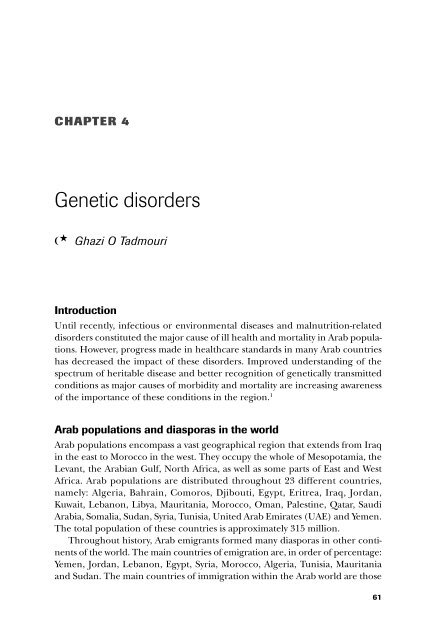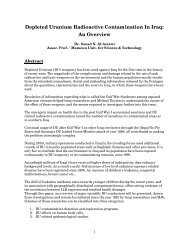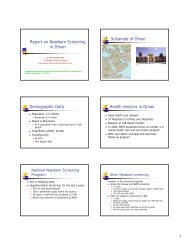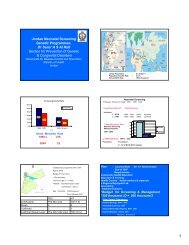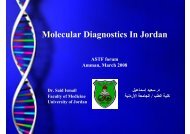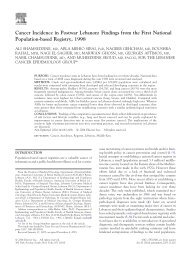Genetic disorders - Jeans4genes.org
Genetic disorders - Jeans4genes.org
Genetic disorders - Jeans4genes.org
You also want an ePaper? Increase the reach of your titles
YUMPU automatically turns print PDFs into web optimized ePapers that Google loves.
64 CARING FOR ARAB PATIENTSthe female partner, the lower the consanguinity rate. 11 On the contrary, in somesocieties, highly educated men are more likely to be married to cousins. 33 Aplausible explanation is that since a son with higher education becomes a morevaluable asset, he is pressured to remain within the family. 11While a declining trend of consanguineous marriages has been documentedin Bahrain, Lebanon, Kuwait and Syria, a stable trend has been reported inJordan and Oman. 33 However, these rates have increased over the last generationin Algeria, 36 the UAE 37 and Yemen. 33 The reason for the rising trend inconsanguinity has been attributed to the increase in the availability of cousinsdue to high fertility. 33Consanguinity and reproductive healthWhile the concept of inheritance is not clear in the minds of many lay people,consanguinity is linked to high incidences of congenital malformations, mentalretardation and disability. Studies indicate that in populations where the practiceof inbred marriages is high, the frequency of homozygosity for autosomal conditionsand the incidence of congenital anomalies, abortions, stillbirths and earlychildhood deaths are likely to rise. 3,38 The reason behind this observation is thatthe more closely two people are related, the more genes they share. A marriagebetween first cousins increases the risk of having a child with a severe congenitalor genetic disorder by 2.5 times since parents share one-eighth of their genes. Anaverage of 30% first cousin marriages in a population would increase the birthprevalence of many conditions by 5–15 times and their collective frequency by5.5 times. Frequent consanguineous marriage increases the incidence of autosomalrecessive <strong>disorders</strong> by 5–10 times at the population level. When first cousinmarriage is considered, the risk of recessively inherited <strong>disorders</strong> is multipliedby 15–30 times; hence, there is a doubling of the total frequency of congenitaland genetic <strong>disorders</strong>. 39While the incidence of recessively inherited <strong>disorders</strong> increases with theincreasing trend of consanguineous marriages, consanguinity has no effecton the frequency of autosomal dominant or X-linked conditions. Autosomaldominant conditions result from just one copy of a deleterious mutation. Thus,having two parents with the same autosomal dominant mutation does not makean individual more susceptible than someone with only one affected parent.Similarly, just one copy of a deleterious X-linked recessive mutation will resultin disease in males. Hence, having related parents does not increase the risk ofa male with X-linked recessive disease.Recently, many studies from the region have drawn strong correlationsbetween consanguinity and hearing loss, 40 death rates in children, 41 respiratoryallergies, eczema, 42 congenital heart defects, 43 mental retardation, epilepsy,diabetes 44 and many other conditions. 1,2
GENETIC DISORDERS 65Arab family structure and transmission geneticsThe extended family structure, commonly present in Arab societies and mostlyassociated with consanguinity, tends to display unique distribution patterns f<strong>org</strong>enetic diseases that are not present in many other societies. A major model thatexplains this concept is the vertical dissemination of a genetic mutation in anArab or in a Western family. In the typical Western family, carriers of mutationsusually become scattered through the general population through marriage.After a few generations, their genetic relationship to each other is unrecognized,therefore a family history suggesting a genetic basis for their predisposition tocertain disease states is easily missed. On the other hand, in an Arab societymutation carriers mostly remain concentrated within the extended family, andthe genetic nature of their disease predisposition is often much more obvious.The economic impact of genetic <strong>disorders</strong><strong>Genetic</strong> <strong>disorders</strong> are chronic in nature and often require lifelong manage mentwith no definitive cure. In the Arab world, several <strong>disorders</strong>, including chromosomal(Down syndrome, Turner syndrome), single-gene (sickle cell disease,thalassemia, glucose-6-phosphate dehydrogenase deficiency, hemophilia, inbornerrors of metabolism) and multifactorial <strong>disorders</strong> (coronary artery disease,arteriosclerosis, diabetes mellitus, hypertension, obesity) are common. Someof these <strong>disorders</strong> have assumed epidemic proportions, as in the cases of sicklecell disease, alpha-thalassemia, hypertension and diabetes mellitus. The impactof each of these <strong>disorders</strong> differs according to their severity, but many of themhave medical, surgical or cosmetic consequences. Often, these conditions resultin spontaneous abortion, neonatal death, and increased morbidity and mortalityin both children and adults. They are a significant healthcare and psychosocialburden for the patient, the family, the healthcare system and the community asa whole. 45In terms of economic burden, patients with genetic or partly genetic <strong>disorders</strong>have longer and more frequent hospital admissions with a higher number ofsurgeries than do other patients. 46,47 Additionally, the total costs paid by patientswith genetic conditions are slightly greater, 48 and these patients often must travelsignificant distances to get specialized treatment. 46In recent years, heath economists have made significant advances in calculatingthe costs of genetic <strong>disorders</strong>, as well as disabilities caused by variouscongenital abnormalities. There are now generally accepted “cost of illness”estimates for all common genetic conditions:✒ beta-thalassemia: treatment of beta-thalassemia major is currently an expensiveoption and has great financial implications for any health authority where thedisease is highly prevalent. The total lifetime (up to 60 years of age) treatmentcosts of a patient with beta-thalassemia are estimated to be $416 000; thus, anaverage of about $7000 annually. 49
66 CARING FOR ARAB PATIENTS✒ sickle cell disease: Davis and colleagues 50 estimated the direct cost of eachhospitali zation associated with sickle cell disease to be $6300. Patients withsickle cell disease are frequent users of healthcare services. On average, a sicklecell disease patient is subject to one hospital admission per year and eightoutpatient visits annually. 51 Although much of the treatment cost is covered bygovernments or supported by non-governmental <strong>org</strong>anizations in the region,this may be changing in some regions. Additionally, many of the patients musttravel long distances, and this adds to the overall cost of treatment.✒ cystic fibrosis: studies have shown that hospitalization costs for patientswith cystic fibrosis vary according to the severity of their disease. However,economists have estimated that the total cost per person with cystic fibrosis tobe about $285 000 over their lifetime, 52 with an annual average of about $9400per patient, of which 28% of total cost is attributable to drug costs. 53✒ hemophilia: like other genetic <strong>disorders</strong>, hemophilia is a lifelong conditionwhich results in profound physical, emotional, economic and social problemsfor those afflicted. The severity of bleeding episodes is correlated with thedegree of deficiency of the Factor VIII protein in the blood. Accordingly,hemophiliacs suffer from mild, moderate or severe disease. Medical expensesvary among patients according to the severity of the deficiency. In themoderate-to-severe group, one study from 1972 estimated medical expensesto exceed $1000 per year. 54 Hemophiliacs may be denied health insurance,thus shifting the costs to the family.✒ congenital bilateral permanent childhood hearing impairment: a recent studyesti mat ing the economic costs of bilateral permanent childhood hearingimpairment (PCHI) in the preceding year of life for children seven to nineyears of age found that the mean societal cost was about $26 700 per child,compared to $8000 in children with normal hearing. 55In 1995, Waitzman and colleagues estimated that the total economic cost ofcerebral palsy, spina bifida, truncus arteriosus, single ventricle, transposition/double outlet right ventricle, tetralogy of fallot, tracheo-esophageal fistula,colorectal atresia, cleft lip or palate, atresia/stenosis of the small intestine, renalagenesis, urinary obstruction, lower limb reduction, upper limb reduction,omphalocele, gastroschisis, Down syndrome, and diaphragmatic hernia inthe United States was $10.8 billion (2004 normalized data) for a single year’scohort. This total cost comprises $2.8 billion in direct healthcare costs and $8billion in indirect costs such as developmental services, special education andlost productivity. If we extrapolate these numbers adjusting for the differencesin population between the United States and all Arab countries, and ignore thefact that many of these 18 birth defects occur more frequently in Arab countriesthan elsewhere, then the cost of these problems in Arab countries is about $13billion per year.
GENETIC DISORDERS 67Preventive aspects of genetic <strong>disorders</strong>The successful management of genetic <strong>disorders</strong> also incurs a high financialcost, which could be eased by the application of effective prevention programsin populations at risk of genetic disease. 56 Prevention programs are effective indecreasing the impact of genetic <strong>disorders</strong> on families and societies and also leadto early treatment and improvements in outcome and prognosis. 57 A majorityof Arab countries have the expertise and resources to apply most of thesepreventive measures, especially in the areas of newborn screening and carrierscreening for prevalent genetic <strong>disorders</strong>. However, having the technologyand resources alone is not enough to start effective programs. For example,population screening should be performed only if the abnormal finding inquestion can change the clinical management, and if this management willimprove the prognosis. Economic considerations are also a factor; the cost ofscreening should justify the financial savings and emotional impact involved indetecting affected individuals. In addition, no genetic screening program willbe successful if it is not accompanied by extensive educational activities aimed atboth the general public and healthcare providers to aid effective participation. 58Furthermore, these programs are most successful when they are sensitive to thecultural backgrounds of populations in which they are applied. 59<strong>Genetic</strong> <strong>disorders</strong> in Arab populationsThe Catalogue for Transmission <strong>Genetic</strong>s in Arabs (CTGA) database is a continuouslyupdated catalogue of bibliographic material and observations on human genevariants and inherited, or heritable, genetic diseases in Arab individuals. Thedatabase is maintained by the Centre for Arab Genomic Studies (www.cags.<strong>org</strong>.ae).Since the public release of the CTGA database in 2004, our knowledge aboutgenetic <strong>disorders</strong> in Arab populations continues to expand. This process is largelydriven by various methods used at the Centre for Arab Genomic Studies (CAGS)to collect data and information on genetic conditions in Arab patients. 1As of May 2007, the CTGA database has recorded the presence of 816phenotype/disease entries in Arab individuals. However, data on only about300 related genes are available in the CTGA database. This is a reflection ofthe fact that clinical observation is emphasized over molecular analysis in mostof the research conducted in the region. The majority of disease records inthe database come from the UAE [241], Saudi Arabia [148], Palestine [127],Lebanon [125], Bahrain [120], Tunisia [94], Egypt [92], Kuwait [83], Morocco[77], and Oman [67]. This distribution is highly preliminary since CAGShas carried out extensive surveys to define the extent of genetic <strong>disorders</strong> inthe UAE (2004–05) and Bahrain (2006–07). Very recently, a new survey waslaunched in Oman and is due for completion in early 2008. On the other hand,data from other Arab countries have been collected through limited reviewsof international bibliographic indices as well as paper submissions from their
GENETIC DISORDERS 69dominant <strong>disorders</strong> comprise 56% and 33%, respectively, of all genetic <strong>disorders</strong>,with 50.5% of marriages being consanguineous. 37 On the other hand, the rateof autosomal recessive <strong>disorders</strong> decreases to 37% – compared to 45% forautosomally dominant <strong>disorders</strong> – in Bahrain, where the rate of consanguineousmarriage is considerably lower, at 39%. 7The spectrum of genetic <strong>disorders</strong> in Arab populationsA recent introduction to the CTGA database is the ability to classify genetic<strong>disorders</strong> according to their incidence rates in the Arab world. Noteworthy aretwo groups of <strong>disorders</strong>:✒ genetic <strong>disorders</strong> that are highly prevalent and occur at annual incidences(> 100 cases per 100000 live births). This group encompasses all hemoglobin<strong>disorders</strong> (thalassemias, sickle cell disease and hemoglobin variants), glucose-6-phosphate dehydrogenase deficiency, Down syndrome, breast cancer,diabetes, anencephaly, Graves disease, Caffey disease, Takayasu arteritis,polycystic kidneys, and other ailments.✒ many other <strong>disorders</strong> do occur in the Arab world at higher incidence rateswhen compared to data from the rest of the world. For example: tetralogyof fallot, familial Mediterranean fever, deafness, Noonan syndrome andankylosing spondylitis.Many of these <strong>disorders</strong> have been extensively researched and reported inthe literature, reflecting their widespread presence in Arab populations.The overwhelming distribution of these diseases in Arabs is best explainedby the exposure of Arab countries to common environmental factors thatencouraged natural selection for these <strong>disorders</strong> such as malaria in the case ofhemoglobinopathies, and dietary traditions in the case of glucose-6-phosphatedehydrogenase deficiency.Other genetic <strong>disorders</strong> exhibit wide geographic distributions encompassingone or more neighboring regions, such as in the cases of the hemolytic-uremicsyndrome and ankylosing spondylitis. Many genetic <strong>disorders</strong> indexed in theCTGA database exhibit sporadic distribution patterns over geographicallydistinct regions in the Arab world. These observations strongly advocate formore regional research on these <strong>disorders</strong> to complete the picture. Candidate<strong>disorders</strong> for further research might include: alpha-thalassemia, cystic fibrosis,familial Mediterranean fever, autosomal recessive polycystic kidney disease,anencephaly, Hirschsprung disease, and others.On the other hand, some genetic diseases exhibit specific geographicdistributions. Examples include:✒ the Maghreb region: type II bare lymphocyte syndrome and the alpha erythrocytic1 spectrin defect✒ North Africa: type 2C of limb-girdle muscular dystrophy✒ the Middle East: dyssegmental dwarfism
GENETIC DISORDERS 7342 Bener A, Janahi I. Association between childhood atopic disease and parental atopicdisease in a population with high consanguinity. Coll Anthropol 2005; 29 (2): 677–82.43 Yunis K, Mumtaz G, Bitar F et al. Consanguineous marriage and congenital heartdefects: a case-control study in the neonatal period. Am J Med Genet A 2006; 140 (14):1524–30.44 Bener A, Hussain R. Consanguineous unions and child health in the State of Qatar.Paediatr Perinat Epidemiol 2006; 20 (5): 372–8.45 Al-Hazmi M. Spectrum of genetic <strong>disorders</strong> and the impact on health care delivery: anintroduction. East Mediterr Health J 1999; 5 (6): 1104–13.46 Carnevale A, Hernandez M, Reyes R et al. The frequency and economic burden ofgenetic disease in a pediatric hospital in Mexico City. Am J Med Genet 1985; 20 (4): 665–75.47 McCandless SE, Brunger JW, Cassidy SB. The burden of genetic disease on inpatientcare in a children’s hospital. Am J Hum Genet 2004; 74 (1): 121–7.48 Hall JG, Powers EK, McIlvaine RT et al. The frequency and financial burden of geneticdisease in a pediatric hospital. Am J Med Genet 1978; 1 (4): 417–36.49 Karnon J, Zeuner D, Brown J et al. Lifetime treatment costs of beta-thalassaemia major.Clin Lab Haematol 1999; 21 (6): 377–85.50 Davis H, Moore RM, Jr, Gergen PJ. Cost of hospitalizations associated with sickle celldisease in the United States. Public Health Rep 1997; 112 (1): 40–3.51 Nietert PJ, Abboud MR, Zoller JS et al. Costs, charges, and reimbursements for personswith sickle cell disease. J Pediatr Hematol Oncol 1999; 21 (5): 389–96.52 Nielsen R, Gyrd-Hansen D. Prenatal screening for cystic fibrosis: an economic analysis.Health Econ 2002; 11 (4): 285–99.53 Schreyogg J, Hollmeyer H, Bluemel M et al. Hospitalisation costs of cystic fibrosis.Pharmacoeconomics 2006; 24 (10): 999–1009.54 Meyers RD, Adams W, Dardick K et al. The social and economic impact of hemophilia– a survey of 70 cases in Vermont and New Hampshire. Am J Public Health 1972; 62 (4):530–5.55 Schroeder L, Petrou S, Kennedy C et al. The economic costs of congenital bilateralpermanent childhood hearing impairment. Pediatrics 2006; 117 (4): 1101–12.56 World Health Organization. Control of Hereditary Diseases. Report of a WHO ScientificGroup. World Health Organization; 1996.57 Al-Odaib AN, Abu-Amero KK, Ozand PT et al. A new era for preventive geneticprograms in the Arabian Peninsula. Saudi Med J 2003; 24 (11): 1168–75.58 Khalifa MM. Preventive aspects of genetic morbidity: experiences of the Canadianmodel. East Mediterr Health J 1999; 5 (6): 1121–8.59 Meyer BF. Strategies for the prevention of hereditary diseases in a highlyconsanguineous population. Ann Hum Biol 2005; 32 (2): 174–9.60 Teebi AS. New autosomal dominant syndrome resembling craniofrontonasal dysplasia.Am J Med Genet 1987; 28 (3): 581–91.61 Teebi AS, Shaltout AA. Craniofacial anomalies, abnormal hair, camptodactyly, andcaudal appendage. Am J Med Genet 1989; 33 (1): 58–60.62 Al Gazali LI, al Talabani J, Mosawi A, Lytle W. Anterior segment anomalies of the eye,clefting and skeletal abnormalities in two sibs of consanguineous parents: Michelssyndrome or new syndrome? Clin Dysmorphol 1994; 3 (3): 238–44.63 Megarbane A, Ruchoux MM, Loeys B et al. Short stature, abnormal face, joint laxity,dislocation, hernias, delayed bone age, and severe psychomotor retardation in two
74 CARING FOR ARAB PATIENTSbrothers: previously undescribed MCA/MR syndrome. Am J Med Genet 2001; 104 (3):221–4.64 Alexander D, Dudin G, Talj F et al. Five related Lebanese individuals with high plasmalysosomal hydrolases: a new defect in mannose-6-phosphate receptor recognition? Am JHum Genet 1984; 36 (5): 1001–14.65 Kozlowski K, Bacha L, Massen R et al. A new type of spondylo-metaphyseal dysplasia –Algerian type: report of five cases. Pediatr Radiol 1988; 18 (3): 221–6.66 Reardon W, Hurst J, Farag TI et al. Two brothers with heart defects and limbshortening: case reports and review. J Med Genet 1990; 27 (12): 746–51.67 Warburg M, Tommerup N, Vestermark S et al. The Yemenite deaf-blindhypopigmentation syndrome: a new oculo-dermato-auditory syndrome. OphthalmicPaediatr Genet 1990; 11 (3): 201–7.68 Teebi AS. Nablus mask-like facial syndrome. Am J Med Genet 2000; 95 (4): 407–8.69 Christodoulou K, Zamba E, Tsingis M et al. A novel form of distal hereditary motorneuronopathy maps to chromosome 9p21.1-p12. Ann Neurol 2000; 48 (6): 877–84.70 Mubaidin A, Roberts E, Hampshire D et al. Karak syndrome: a novel degenerativedisorder of the basal ganglia and cerebellum. J Med Genet 2003; 40 (7): 543–6.71 Rajab A, Kunze J, Mundlos S. Spondyloepiphyseal dysplasia Omani type: a newrecessive type of SED with progressive spinal involvement. Am J Med Genet A 2004;126 (4): 413–19.72 Hamamy H, Alwan A. Hereditary <strong>disorders</strong> in the Eastern Mediterranean region. BullWorld Health Organ 1994; 72 (1): 145–54.73 Axton M. The germinating seed of Arab genomics. Natural <strong>Genetic</strong>s 2006; 38 (8): 851.


